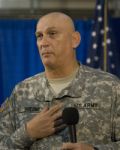WASHINGTON, Feb. 9, 2011 — The commander of U.S. Joint Forces Command today outlined some of the changes that will take place over the next several months as he oversees the disestablishment of the southern Virginia-based organization responsible for the military’s joint training, doctrine and operations.
Defense Secretary Robert M. Gates announced in August that he would recommend the command be eliminated and its essential functions assigned to other organizations, and President Barack Obama approved the command’s disestablishment Jan. 6.
Army Gen. Raymond T. Odierno spoke with reporters at the Joint Warfighting Center in Suffolk, Va., and shared his vision for the reorganization. “What I hope to see is that we’re able to do our job better to support combatant commands in the services as they request help,” he said, “whether it’s conducting training exercises around the world or developing new doctrines for Afghanistan or ballistic missile defense or other areas.”
Gates signed a memorandum this morning providing guidance and direction to execute the disestablishment, Odierno said.
“The changes are significant,” he added. “We will retain the most critical functions and expertise for the joint warfighter in an organization flattened for agility and efficiency. But I do want to stress that this will be a different organization.”
In the months ahead, streamlined relevant joint functions will be transferred to “appropriate Defense Department entities, mostly the Joint Staff,” Odierno said. “We’ll ensure that we sustain the momentum and gains in jointness while maintaining critical interaction with NATO, specifically Allied Command Transformation, and other multinational partners.”
Allied Command Transformation, based in Norfolk, Va., is a NATO military command that provides the conceptual framework for conducting combined joint operations.
Odierno said he’s required over the next 30 days to publish a detailed implementation plan and submit it to Gates.
“During this time,” the general said, “I will continue to refine the details of this plan, and will continue to refine it as we begin execution of the plan.”
A two-star general officer will lead the new organization from Norfolk-Suffolk as deputy director for operational plans and joint force development on the Joint Staff. Joint Forces Command will be disestablished as a four-star combatant command by the end of August, and all personnel moves will be complete by March 2012.
“Today we have 33 liaison officers as part of Joint Forces Command,” Odierno said. “They will remain connected to the Joint Warfighting Center. We have requests for 17 other nations to join us here, and that will continue to be programmed.”
The general said the command’s outlying centers and agencies will be realigned and reduced for efficiency and assigned to other combatant commands. No physical moves are projected with the transfers.
These include the Joint Warfare Analysis Center in Dahlgren, Va.; the Personnel Recovery Agency in Fort Belvoir, Va.; the Joint Communications and Support Element at MacDill Air Force Base in Tampa, Fla.; and the NATO School in Germany.
Joint Forces Command service components include Fleet Forces Command, Air Combat Command, Marine Forces Command and Army Forces Command, Odierno said, and each will revert to their respective service’s control Aug. 1.
The reorganized command will retain 51 percent of its Virginia work force, which will be reduced from about 4,700 people to 2,425. In the Norfolk-Suffolk area, the work force will drop to 1,900 from 3,800 people, and from 21 buildings to four.
“[Joint Forces Command] is one of the small pieces of a larger DOD efficiency effort,” Odierno said. “That piece, though, is important, and it’s personal to everyone here. I will place the highest priority on the execution and disestablishment and taking care of all our employees.”
Odierno said he and his staff understand the impact the command’s disestablishment will have on its workers.
“We are engaged with the Office of the Secretary of Defense Personnel and Readiness, the Navy Personnel Office’s human resource offices, and the entire Virginia delegation, both local and national, as well as the governor’s office,” he said, “to make sure our work force receives the best professional career advice and placement assistance available.”
The bulk of the reductions will affect contractors, he said, but some military and government civilian reductions also will take place.
“I absolutely agree with what we’re trying to do here,” Odierno added, “but the proof will be in our execution to make sure that we get this new organization right.”
Source:
U.S. Department of Defense
Office of the Assistant Secretary of Defense (Public Affairs)

 von
von 